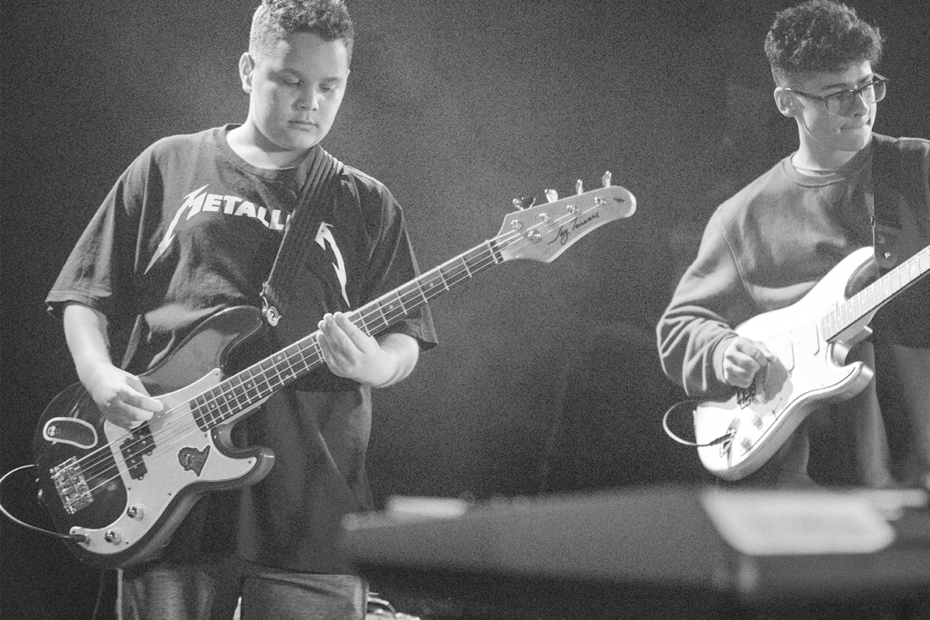If you watched at least a dozen music videos where bass players are shown playing their instruments, you may have noticed that some musicians use a pick, some use their fingers, and some alternate between the two.
Even though professionals who’ve played for decades are adept at both of these playing styles, shifting between playing with your pick and with your fingers might be hard if you’re a beginner. Furthermore, your desired playing style will influence your tone and make some things easier (or harder), such as playing super-fast licks in metal or hitting the right groove in rock or blues.
Knowing that choosing the right playing style is very important for newcomers, The Music Box bass coaches wish to share their knowledge and give valuable advice to beginners.
Fingerstyle Bass
The predecessor of the electric bass guitar is the double bass (upright bass) – an instrument that was bowed almost like a violin. Musicians eventually realized that even though the strings on a double bass were much thicker and harder than the ones on a guitar, they could use their fingers to produce a different, more controlled sound.
Fast-forward to today’s times, bass makers are using cutting-edge technology to create all kinds of bass string gauges, enabling anyone to find the right thickness and feel, so fingerstyle playing became slightly easier and more comfortable.
The Technique
When a bass is played fingerstyle, the plucking hand usually rests on the pickup, or the top of the body. This is a comfortable position for the player to effortlessly reach the desired string/s while avoiding unnecessary arm fatigue.
The index and middle fingers are mainly used unless specific bass-playing techniques are called for, such as galloping in metal music (that’s where the ring finger comes into play), or even all fingers excluding the thumb for more complex licks. The thumb is primarily used for popping and slapping techniques. If you want to see how our students are applying theory to practice, swing by our Facebook page.
The Sound
When the strings of the bass are plucked with fingers, your tone will be “rounder”, with a slightly higher emphasis on low and treble frequencies. This is mainly so because the fingertips are much softer than a guitar pick.
Controlling the volume of your notes is also slightly easier. Notes can be accentuated by pulling the string harder.
Furthermore, it’s also fairly easy to pull non-adjacent strings (for example, E and D) without scratching the ones in between, leading to a clearer sound when octaves are played along with the base notes.
Most of our students have managed to find a great tone in merely a couple of weeks of learning at The Music Box. Come to our Instagram page if you want to hear them rock out to their favorite tunes.
The Learning Curve
For many people, playing electric bass with fingers is harder than playing it with a pick because there’s a bit of pain involved during the learning process.
The fingertips of non-musicians are usually very soft; pulling the strings will almost inevitably lead to small skin crusts, which will eventually rupture. While the tips heal, they harden, meaning that the process will become far easier and less painful over time.
Another big hurdle when it comes to fingerstyle bass playing is the plucking accuracy. Most beginners need some time to accurately memorize the spacing between the strings; reaching the next string needs to be executed in a split second in most songs.

Playing Bass with a Pick
An electric bass can be played like an electric guitar, but you’ll usually need a slightly thicker pick (guitar picks are often ultra-thin and may break after a few days when used on bass strings).
Guitarists who have some experience on a guitar often go with this approach simply because it’s more familiar.
The Technique
When playing bass with a pick, the technique is almost identical to guitar picking. Place the pick between your thumb and index finger, and then place your hand on the lower end of your strings. Move the pick down to strike the desired string.
There are many variations of the bass picking technique, including “standard” picking (upstrokes or downstrokes), alternate picking (alternating between upstrokes and downstrokes continuously), and hybrid picking (alternate picking combined with using fingers).
Some bass-playing techniques are much easier to execute when a pick is used, such as playing notes very fast, playing power chords, and such.
The Sound
The sound of a bass guitar is “sharp” when a pick is used. The thickness, material, and sharpness of the pick greatly influence the overall tone, but fortunately, you can always buy a different pick if the one you’re currently using is not giving you the desired sound.
For beginners, controlling the tone is slightly more difficult with a pick (compared to fingerstyle) since they are yet to become familiar with the pick and their chosen instrument. Come to our TikTok page to see how some of our brightest students are playing legendary rock songs.
The Learning Curve
For guitarists-turned-bassists, the learning process is very straightforward. The only thing you’ll need to do is get a feel for the different spacing between the frets and the strings.
For newcomers who’ve never played an instrument before, starting out with the pick style is probably the safest choice since it’s painless. Many greenhorn bassists have fallen out of love with their instrument simply because they couldn’t put up with the ache in their fingertips.
Ready to Start Learning? Come to The Music Box!
Whichever playing style you’ve decided to go with, you can rest assured that our bass coaches will help you learn everything there is to know, and more.
Swing by our HQ at 4321 Gunn Highway, Carrollwood, Florida, or send us an email if you need more info. If you’re ready to begin right away, just follow this link, and we’ll help you through the rest of the process.



